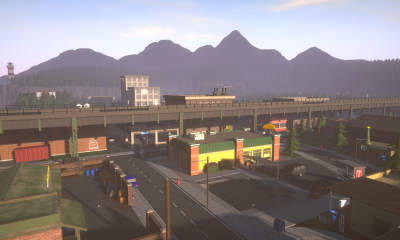Schedule I
From the moment I booted up Schedule I, I felt as if I had stepped into a realm where every detail was a careful blend of bold imagination and meticulous execution. My initial encounter with the game was not just a matter of clicking a start button but rather an immersion into a universe that challenged my preconceptions of interactive storytelling. The game’s title hinted at layers of complexity, and through my exploration, I discovered that each facet is deliberately crafted to evoke a sense of urgency and wonder.
I had long anticipated a narrative that transcended traditional constructs and embraced innovative mechanics, and Schedule I accomplished that by forging deep connections between its mechanics and its narrative drive. Even as the storyline weaved through unexpected territories, the emotional core was consistently maintained through strategic gameplay and an engaging storyline that kept me invested in every decision I made.
The Tapestry of the Narrative
As I proceeded further, I found that the narrative had an almost poetic fluidity, connecting seemingly disjointed encounters with subtle thematic developments. The world of Schedule I is not merely a background for action but evolves as a character in its own right. I experienced moments where the narrative shifted from intense, personal insights to broader, philosophical inquiries about society and individual purpose—an aspect that consistently urged me to reflect on my own choices.
The game’s storyline did not rely on clichéd tropes; instead, it unraveled layers of intricate subplots that explored personal conviction, moral ambiguity, and the consequences of actions. The dialogues, often charged with emotional depth and subtle hints of irony, left me pondering the broader implications of every quest and side mission. It felt as though the narrative was a living, breathing entity that evolved with each layer of my interaction.
The Dynamic Core of Gameplay
The gameplay mechanics of Schedule I present a dynamic interplay of strategy and spontaneity that captivated me from the outset. I found that every decision I made was met with a cascade of consequences, as the game adeptly balanced predetermined plots with emergent situations that required swift adaptation. Every moment, whether it was navigating a labyrinthine environment or making split-second decisions in emerging scenarios, was delivered with a refined sense of balance and precision.
One of the facets that I appreciated most was the variety of playable strategies. The game encouraged me to experiment and reassess conventional tactics, rewarding creative thinking and adaptive execution. The interface was seamlessly integrated into the gameplay, ensuring that my attention never wavered from the unfolding drama but remained ever-ready to tackle the next challenge with flexibility and finesse.
The Elegance of User Interface Exploration
Navigating the world of Schedule I was more than a technical exercise; it was an exploration of a user interface designed to be both intuitive and multifaceted. I could traverse various menus and interactive elements with minimal friction, which allowed me to focus on the world’s intricate narrative and intricate challenges. The layout was meticulously designed, ensuring that each control was both accessible and contextually relevant to the evolving gameplay experience.
I found that the design team had carefully balanced visual cues and interactive prompts, reinforcing my immersion throughout the game. This level of attention to both aesthetics and functionality made managing resources, accessing maps, and even pausing for a moment of reflection an almost seamless activity. The ergonomics of control and navigation played a significant role in keeping me engaged, as every part of the interface contributed to a dynamic, living world where every detail was important.
The Art of Visual Storytelling
Visually, Schedule I captured my imagination with its bold color palette and intricate design elements. The environments ranged from bleak, dystopian corridors to vibrant, dynamic landscapes teeming with life. Every scene was imbued with a unique character and a sense of history, be it through weathered textures that suggested past conflicts or luminous vistas that evoked hope amid adversity.
I marveled at the meticulous detail present in every corner of the game. The use of lighting, shadow, and texture not only elevated the aesthetic appeal but also functioned as an integral element of storytelling. The way subtle hints in the background could foreshadow pivotal moments in the narrative only served to heighten my engagement. It quickly became evident that visual storytelling in Schedule I was as crucial as any other aspect of its design, inviting me to constantly explore and discover hidden nuances.
The Symphony of Audio and Silence
A remarkable part of my experience was the auditory landscape of Schedule I. The game marries ambient sounds with a carefully composed musical score that enhances the emotional resonance of every scene. As I navigated through different settings, the musical cues shifted gracefully, mirroring the emotional tone and complexity of the current narrative moment.
There were instances where the absence of sound was as powerful as the music itself. The deliberate use of silence in key moments allowed the narrative's dramatic turns to stand out, inviting introspection and deep concentration. I could sense the developers’ attention to auditory detail, ensuring that each sound cue and moment of silence worked in harmony to support the immersive quality of the game. This intricate interplay transformed routine gameplay into profound, almost cinematic experiences.
The Innovation of Technological Design
The backend structure of Schedule I is a testament to advanced technological design that underpins a seamless user experience. I was impressed by how the game balanced graphical fidelity with performance, ensuring that even extended sessions were without lag or disruption. The fluidity of the game's performance was a strong indicator of sophisticated coding and thorough testing processes.
Underlying mechanics such as dynamic AI, real-time environmental shifts, and intricate simulation algorithms all contributed to a robust gameplay experience that felt fresh and challenging. I found that the technology not only facilitated immersive interactions but also fostered a world that was responsive and alive. This melding of technology and creative vision made every technical element an enabler for storytelling and exploration.
The Architecture of Immersive Worlds
Schedule I offered me an immersive experience that combined vast, sprawling environments with meticulously crafted intimate details. The game world, though expansive, never felt empty. I encountered dynamic ecosystems where every locale had its own rhythm and contributed uniquely to the overarching narrative. From shadowy alleyways dotted with cryptic symbols to sun-dappled plazas pulsating with life, the environments were thoughtfully constructed to encapsulate a diverse range of moods.
I found my exploration continuously rewarded by hidden layers of detail. The ambient life, the NPC interactions, and even minor side quests subtly reinforced the world’s history and ongoing evolution. This level of detail provided me with a game world that felt both epic in scale and personal in relevance, attesting to the developers’ commitment to creating a space that was as emotionally engaging as it was visually spectacular.
The Challenge of Tactical Decision Making
One of the areas in which I was most challenged was the game’s approach to strategic engagements. Schedule I is constructed around moments that demand thoughtful tactical planning, with each decision carrying potential long-lasting effects. I was frequently tasked with balancing immediate risks against long-term rewards, which required both foresight and rapid adaptability.
The combat and puzzle-solving routines were particularly engrossing, often requiring me to step back and consider the entire battlefield or scenario before acting. This emphasis on thoughtful decision making wasn’t just about survival—it was about crafting a personal narrative of resilience and adaptability. I appreciated how every challenge was a learning opportunity, gradually enriching my overall gameplay and deepening my connection to the unfolding drama.
The Evolution of Interactive Narratives
Schedule I excels in its delivery of an interactive narrative that responds dynamically to player choices. I was struck by how every branch of dialogue and every decision tree seemed tailor-made to reflect the unique path I was creating. The narrative threads adjusted to my style of play, and even seemingly minor choices had the potential to steer the storyline toward unpredictable developments.
This transformative narrative structure meant that my experience was highly personalized. I encountered scenarios that pushed me to reexamine my ethics and reassessed my priorities in a world where right and wrong were rarely clear. The branching pathways woven into the game were intricate and provided a level of replayability that I found both challenging and invigorating. It was an experience that rewarded introspection and encouraged me to consider every option carefully.
The Allure of Minimalist Design Elements
While Schedule I is richly layered in content and detail, I was also drawn to its minimalist design elements that efficiently conveyed both function and emotion. The minimalism was not a lack of content but rather an intentional aesthetic choice that highlighted the significance of each visual and narrative moment. I admired how understated cues in the design could communicate volumes about underlying tensions and forthcoming challenges.
Even when the environments were stark and the palettes subdued, the artistry was evident in every shadow and line. This balance of simplicity and complexity felt like a tightrope walk between maintaining clarity and embracing artistic flourishes. I found that the minimalist elements served as a canvas on which the more elaborate textures of the narrative could truly shine, ensuring that every element worked in concert to create an impactful experience.
The Interplay of Character and Environment
In my journey through Schedule I, one of the most compelling aspects was the relationship between the characters I encountered and the environments they inhabited. The characters were multi-dimensional, each with their own motivations and histories intricately tied to the world around them. I found that dialogue exchanges were enriched by the setting, with every conversation subtly enhanced by the background context that was ever-present in the game.
This interplay was particularly rewarding when moments of personal connection arose. I felt that my interactions with these characters were meaningful impulses that echoed in the very architecture of the world. The synergy between characters and their surroundings created scenarios that were unexpected and deeply engaging, inviting me to immerse myself fully in the richly woven narrative tapestry that Schedule I presented.
The Fluidity of Emotional Engagement
Throughout my time immersed in Schedule I, I encountered a spectrum of emotions that were carefully elicited by the game’s architecture. At times, moments of quiet introspection allowed me to fully absorb the weight of every narrative twist. Other instances charged my adrenaline with pulses of urgency and the palpable tension of unforeseen turmoil. The natural oscillation between calm and intensity was orchestrated to perfection, making every session a rollercoaster of emotional highs and reflective lows.
This fluidity in emotional engagement became one of the key features that defined my personal experience. I was drawn into the game not as an outsider but as an integral part of its unfolding drama, reacting dynamically to every twist and turn of the narrative. The emotional cadence was carefully controlled, ensuring that moments of vulnerability were met with a balance of hope and resolve—a dynamic that kept my experience fresh and continuously compelling.
An Intimate Voyage of Self-Discovery
Finally, my time with Schedule I evolved into a deeply personal journey of self-discovery. As the narrative unfolded and I navigated the varied gameplay challenges, I found that the game offered more than just entertainment; it presented an opportunity to explore facets of my own decision-making processes and emotional responses. Every complex scenario and each thoughtfully constructed environment contributed to moments where I could truly reflect on my own values and aspirations.
Engaging with the game’s intricacies allowed me to recognize parallels between the digital world I was traversing and the multifaceted nature of my own experiences. In moments where the narrative made me pause and consider the broader implications of my choices, I sensed that Schedule I was not merely a game but a catalyst—a mirror that reflected back my inner landscape. This personal connection ensured that my time in the world of Schedule I was as introspective as it was exhilarating.
How to Download and Play Schedule I on Different Platforms
Schedule I is a free game available on a wide range of platforms. Whether you are using a PC, Mac, console, or mobile device, this guide will help you download, install, and play the game. Read the sections below for important details about system requirements, platform availability, and more.
Windows PC: Schedule I is available for Windows PC. You can download the game directly from the official Schedule I website. Make sure your computer meets the minimum system requirements.
Mac: The game is not officially available for macOS. If you want to play on a Mac, you might need to use a cloud gaming service or an emulator.
Chromebook: Schedule I is not officially supported on Chromebooks. However, you may try cloud gaming options like Xbox Cloud Gaming or NVIDIA GeForce Now to play the game.
PlayStation 5: The game is fully supported on PlayStation 5. Download it from the PlayStation Store.
PlayStation 4: Schedule I is available on PlayStation 4 and can be downloaded from the PlayStation Store.
PlayStation 3: The game is not available on PlayStation 3.
Xbox One: If you have an Xbox One, you can download Schedule I from the Microsoft Store.
Xbox 360: The game is not available on Xbox 360.
Xbox Cloud: Schedule I is supported via Xbox Cloud Gaming. You will need an Xbox Game Pass Ultimate subscription to play through this service.
Nintendo Switch: The game is available on Nintendo Switch. You can download it from the Nintendo eShop.
Android: Schedule I is available on Android devices. Download it from the official app page or from alternative trusted app stores if needed.
iOS (iPhone/iPad): The game is not available on the App Store for iOS devices. As a workaround, you may consider cloud gaming services if they are available in your region.
To install Schedule I, download the game from the official store or website matching your device and follow the installation instructions. For devices that do not support a native installation, cloud gaming services are a good alternative.
On PC, Schedule I requires at least an Intel Core i3 processor, 8 GB RAM, and a DirectX 11-compatible GPU. For Android devices, a 64-bit operating system and support for the Vulkan API are needed.
Schedule I is an online multiplayer game, which means that using Cheats or Mods is not allowed. Using any unauthorized modifications may result in a permanent ban from the game.
Please note that Schedule I may not work unblocked at school or work. To play the game in such environments, you might need to use VPNs or cloud gaming platforms, although these options may also be restricted.

























Leave a comment
Your comment is awaiting moderation. We save your draft here
0 Comments